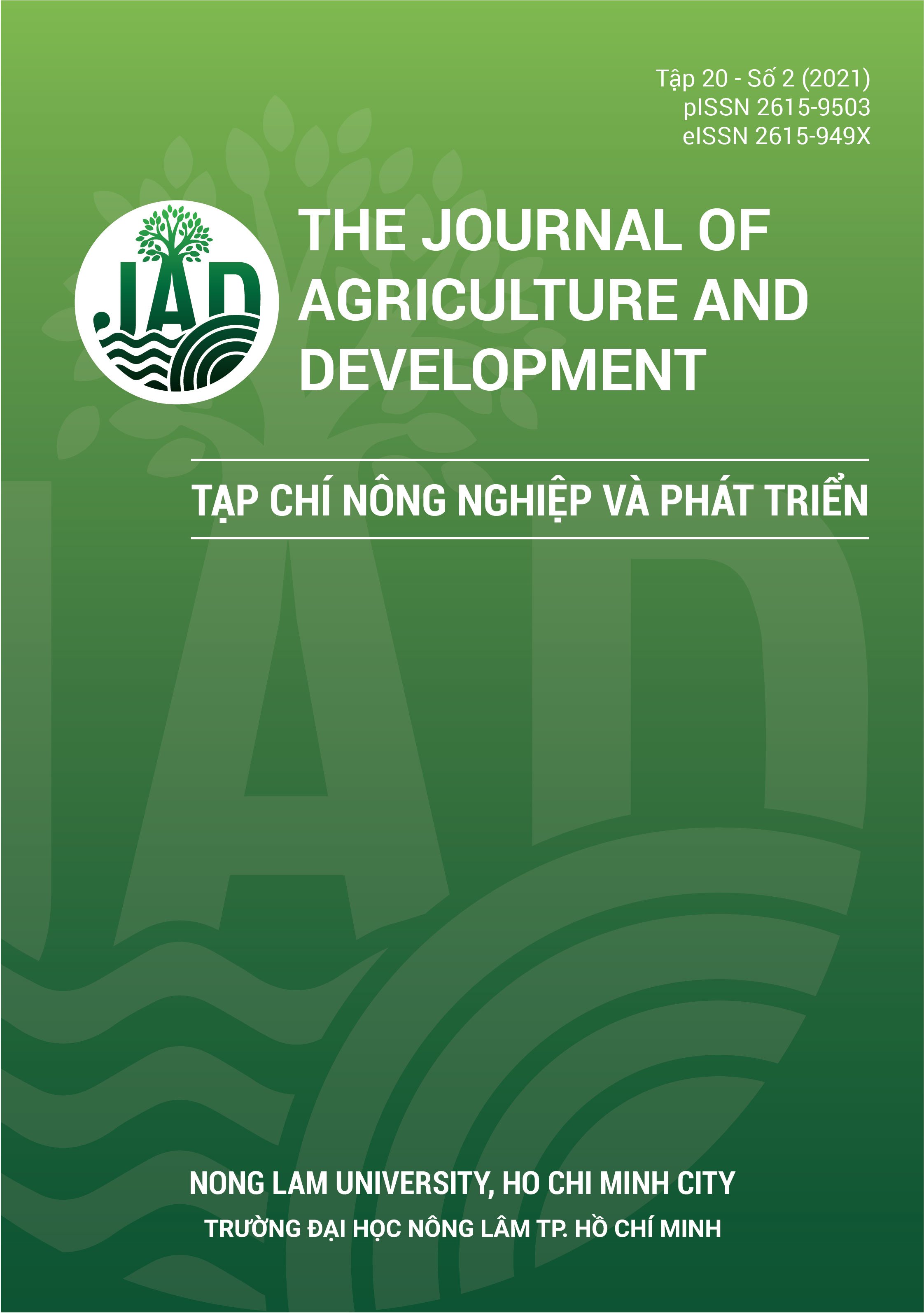Điều kiện vệ sinh của môi trường chế biến và mật số vi sinh vật trên cá Tra (Pangasius hypophthalmus): Công đoạn chỉnh hình
Main Article Content
Tóm tắt
Trong quá trình chế biến cá Tra phi lê đông lạnh, mật số vi sinh vật phụ thuộc vào nguồn nguyên liệu và điều kiện chế biến và do đó có ảnh hưởng đáng kể đến chất lượng của thành phẩm. Chỉnh hình được xem là công đoạn có nguy cơ cao lây nhiễm trong quy trình chế biến. Nghiên cứu này được thực hiện nhằm đánh giá và so sánh mật số vi sinh vật tại công đoạn chỉnh hình ở bốn nhà máy chế biến cá Tra phi lê đông lạnh thuộc khu vực Đồng bằng sông Cửu Long. Mẫu cá chỉnh hình và môi trường chế biến (các bề mặt tiếp xúc như găng tay công nhân và dụng cụ chế biến) được đánh giá các chỉ tiêu vi sinh vật bao gồm: vi sinh vật tổng số hiếu khí, Coliforms, E. coli và Staphylococci dương tính coagulase (Staphylococci coa+). Kết quả cho thấy mật số vi sinh vật tổng số hiếu khí trên cá chỉnh hình ở bốn nhà máy A, B, C và D lần lượt là 7,1 ± 0,4; 7,5 ± 0,7; 6,7 ± 1,1 và 6,0 ± 0,4 log CFU/g. Mật số Coliforms, E. coli và Staphylococci coa+ trên cá chỉnh hình tại các nhà máy tương ứng dao động từ 4,0 - 5,1; 2,1 - 3,7 và 1,8 - 4,2 log CFU/g. Nghiên cứu thấy rằng cần có phương pháp bảo quản phù hợp cá bán thành phẩm trong suốt quá trình chế biến. Thực hành vệ sinh và sản xuất tốt cần được thực hiện hiệu quả để giảm thiểu nguy cơ nhiễm chéo cho cá bán thành phẩm.
Article Details
Tài liệu tham khảo
Da Silva Meira, Q. G., de Medeiros Barbosa, I., Athayde, A. J. A. A., de Siqueira-Júnior, J. P., & de Souza, E. L. (2012). Influence of temperature and surface kind on biofilm formation by Staphylococcus aureus from food-contact surfaces and sensitivity to sanitizers. Food Control 25(2), 469-475. https://doi.org/10.1016/j.foodcont.2011.11.030
Di Ciccio, P., Vergara, A., Festino, A. R., Paludi, D., Zanardi, E., Ghidini, S., & Ianieri, A. (2015). Biofilm formation by Staphylococcus aureus on food contact surfaces: Relationship with temperature and cell surface hydrophobicity. Food Control 50, 930-936. https://doi.org/10.1016/j.foodcont.2014.10.048
ISO (International Organization for Standardization). (2004). Microbiology of food and animal feeding stuffs – horizontal methods for sampling techniques from surfaces using contact plates and swabs (ISO 18593:2004). Retrieved April 9, 2020, from https://www.iso.org/standard/39849.html.
ISO (International Organization for Standardization). (2003). Microbiology of food and animal feeding stuffs - preparation of test samples, initial suspension and dec- imal dilutions for microbiological examination - part 2: Specific rules for the preparation of meat and meat products (ISO 6887-2:2003). Retrieved April 9, 2020, from https://www.iso.org/standard/29866.html.
Kulawik, P., Migdal, W., Gambu´s, F., Cie´slik, E., O¨ zo˘gul, F., Tkaczewska, J., Szczurowska, K., & Walkowska, I. (2016). Microbiological and chemical safety concerns regarding frozen fillets obtained from Pangasius sutchi and Nile tilapia exported to European countries. Journal of the Science of Food and Agriculture 96(4), 1373-1379. https://doi.org/10.1002/jsfa.7233
Lang, M. M., Ingham, S. C., & Ingham, B. H. (1999). Verifying apple cider plant sanitation and hazard analysis critical control point programs: choice of indicator bacteria and testing methods. Journal of Food Protection 62(8), 887-893. https://doi.org/10.4315/0362-028X-62.8.887
Noseda, B., Thi, A. N. T., Rosseel, L., Devlieghere, F., & Jacxsens, L. (2013). Dynamics of microbiological quality and safety of Vietnamese Pangasianodon hypophthalmus during processing. Aquaculture International 21(3), 709-727. https://doi.org/10.1007/s10499-012-9605-6
Novoslavskij, A., Terentjeva, M., Eizenberga, I., Valciņa, O., Bartkevičs, V., & Bērziņš, A. (2016). Major foodborne pathogens in fish and fish products: A review. Annals of Microbiology 66(1), 1-15. https://doi.org/10.1007/s13213-015-1102-5
Shikongo-Nambabi, M. N. N. N., Chimwamurombe, P. M., & Venter, S. N. (2010). Factors impacting on the microbiological quality and safety of processed hake. African Journal of Biotechnology 9(49), 8405-8411.
Shikongo-Nambabi, M. N. N. N., Shoolongela, A., & Schneider, M. B. (2011). Control of bacterial contami- nation during marine fish processing. Journal of Biology and Life Science 3(1), 1-17. http://dx.doi.org/10.5296/jbls.v3i1.1033
Svanevik, C. S., Roiha, I. S., Levsen, A., & Lunestad, B. T. (2015). Microbiological assessment along the fish production chain of the Norwegian pelagic fisheries sector–results from a spot sampling programme. Food Microbiology 51, 144-153. https://doi.org/10.1016/j.fm.2015.05.016
TCVN (Vietnamese National Standards). (2005). TCVN 4830-1:2005: Vietnamese standard on microorganism in food and animal feeds - Method for determination of Staphylococcus aureus. Retrieved February 26, 2021, from https://vanbanphapluat.co/tcvn-4830-1-2005-dinh-luong-Staphylococci-co-phan-ung-duong- tinh-coagulase.
Tong, T. A. N., Duyen, B. T. H., Loan, L. N. T. T., Nghia, L. D., Duy, L. N. D., Binh, L. N., & Devlieghere, F. (2014). Comparison of Tra fish production process at seafood processing factories: microbial quality of total aerobic counts. Can Tho University Journal of Science 32 (2014), 69-75.
Tong, T. A. N., Phan, T. T. Q., & Huynh, T. P. L. (2020). Textbook: Safety and pollution in food production. Can Tho City, Vietnam: Can Tho University Publishing House.
VASEP (Vietnam Association of Seafood Ex- porters and Producers). (2021). Value chain of Pangasius. Retrieved February 28, 2021, from http://vasep.com.vn/san-pham-xuat-khau/ca-tra/nguyen-lieu/hinh-thanh-chuoi-gia-tri-nganh-hang- ca-tra-21000.html.
VASEP (Vietnam Association of Seafood Exporters and Producers). (2019). Overview of Vietnam fisheries industry. Retrieved April 1, 2020, from http://vasep.com.vn/1192/OneContent/tong-quan-nganh.htm.








